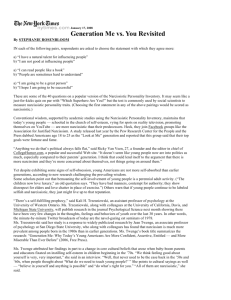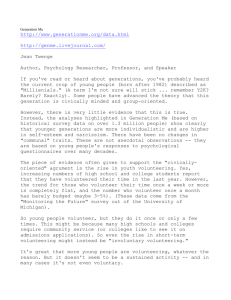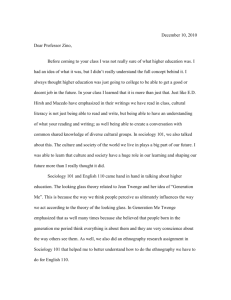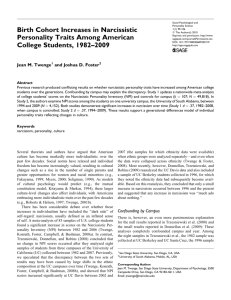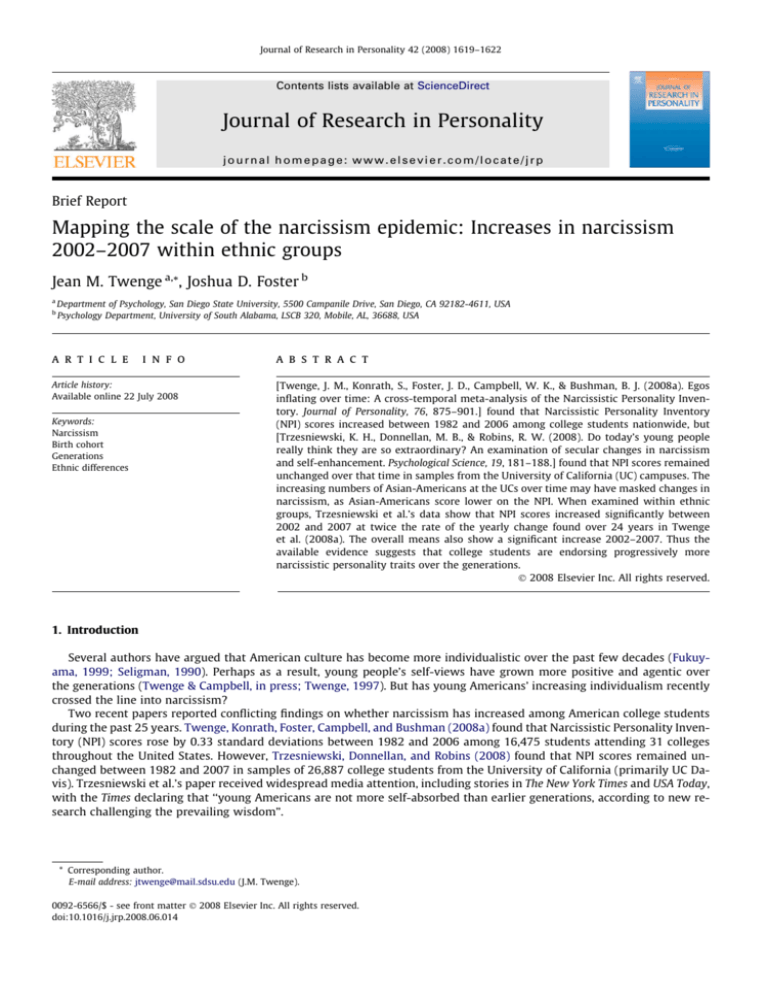
Journal of Research in Personality 42 (2008) 1619–1622
Contents lists available at ScienceDirect
Journal of Research in Personality
journal homepage: www.elsevier.com/locate/jrp
Brief Report
Mapping the scale of the narcissism epidemic: Increases in narcissism
2002–2007 within ethnic groups
Jean M. Twenge a,*, Joshua D. Foster b
a
b
Department of Psychology, San Diego State University, 5500 Campanile Drive, San Diego, CA 92182-4611, USA
Psychology Department, University of South Alabama, LSCB 320, Mobile, AL, 36688, USA
a r t i c l e
i n f o
Article history:
Available online 22 July 2008
Keywords:
Narcissism
Birth cohort
Generations
Ethnic differences
a b s t r a c t
[Twenge, J. M., Konrath, S., Foster, J. D., Campbell, W. K., & Bushman, B. J. (2008a). Egos
inflating over time: A cross-temporal meta-analysis of the Narcissistic Personality Inventory. Journal of Personality, 76, 875–901.] found that Narcissistic Personality Inventory
(NPI) scores increased between 1982 and 2006 among college students nationwide, but
[Trzesniewski, K. H., Donnellan, M. B., & Robins, R. W. (2008). Do today’s young people
really think they are so extraordinary? An examination of secular changes in narcissism
and self-enhancement. Psychological Science, 19, 181–188.] found that NPI scores remained
unchanged over that time in samples from the University of California (UC) campuses. The
increasing numbers of Asian-Americans at the UCs over time may have masked changes in
narcissism, as Asian-Americans score lower on the NPI. When examined within ethnic
groups, Trzesniewski et al.’s data show that NPI scores increased significantly between
2002 and 2007 at twice the rate of the yearly change found over 24 years in Twenge
et al. (2008a). The overall means also show a significant increase 2002–2007. Thus the
available evidence suggests that college students are endorsing progressively more
narcissistic personality traits over the generations.
Ó 2008 Elsevier Inc. All rights reserved.
1. Introduction
Several authors have argued that American culture has become more individualistic over the past few decades (Fukuyama, 1999; Seligman, 1990). Perhaps as a result, young people’s self-views have grown more positive and agentic over
the generations (Twenge & Campbell, in press; Twenge, 1997). But has young Americans’ increasing individualism recently
crossed the line into narcissism?
Two recent papers reported conflicting findings on whether narcissism has increased among American college students
during the past 25 years. Twenge, Konrath, Foster, Campbell, and Bushman (2008a) found that Narcissistic Personality Inventory (NPI) scores rose by 0.33 standard deviations between 1982 and 2006 among 16,475 students attending 31 colleges
throughout the United States. However, Trzesniewski, Donnellan, and Robins (2008) found that NPI scores remained unchanged between 1982 and 2007 in samples of 26,887 college students from the University of California (primarily UC Davis). Trzesniewski et al.’s paper received widespread media attention, including stories in The New York Times and USA Today,
with the Times declaring that ‘‘young Americans are not more self-absorbed than earlier generations, according to new research challenging the prevailing wisdom”.
* Corresponding author.
E-mail address: jtwenge@mail.sdsu.edu (J.M. Twenge).
0092-6566/$ - see front matter Ó 2008 Elsevier Inc. All rights reserved.
doi:10.1016/j.jrp.2008.06.014
1620
J.M. Twenge, J.D. Foster / Journal of Research in Personality 42 (2008) 1619–1622
In our reply to their set of results (Twenge, Konrath, Foster, Campbell, & Bushman, 2008b), we argued that Trzesniewski
et al. (2008) failed to find an increase in narcissism because Asian-American enrollment at the UC campuses nearly doubled
over the time of their investigation, and Asians typically score lower on individualistic traits (Heine, 2007; Twenge & Crocker,
2002), including narcissism (Foster, Campbell, & Twenge, 2003). For example, among college age (18–23) participants in Foster et al.’s (2003) data, Asian-Americans scored 0.21 SDs lower on the NPI than White Americans. Thus as proportionally
more Asian-American students entered the samples used by Trzesniewski et al., NPI means would appear to remain constant
(or go down) even if scores within ethnic groups actually increased.
Unfortunately, Trzesniewski et al. did not report their data broken down by ethnic group. Trzesniewski et al. did report that the interaction between ethnicity and time was not significant. However, that is a different question: If NPI
means increased similarly within each ethnic group, there would indeed be no interaction between time and ethnicity.
Examining the pattern of change within ethnic groups, however, eliminates the possible confound of samples changing
in ethnic composition over time (e.g., the percentage of Asian-Americans in the samples rising over time). Both generational differences and ethnic group membership reflect the impact of culture on the individual (Heine, 2007; Twenge,
2006). These effects can be additive (or, in this case, subtractive), so if both change over time, generational effects might
not appear. Because ethnicity data were only available for the 2002–2007 samples, we examined change in NPI scores
over only this 5-year period, another difference from Trzesniewski et al., who concentrated on the change between 1982
and 2007.
2. Method
Trzesniewski et al. graciously provided the NPI means for their UC Davis samples separated into four ethnic groups:
Whites, Blacks, Hispanics, and Asians. Respondents who did not answer the ethnicity question or who chose ‘‘other” are
not included in this analysis. Trzesniewski et al. noted that means broken down by ethnic group were only available for
the 2002–2007 samples; thus the 1996 and 1979–1985 datapoints from their paper are not included here. The 1979–
1985 datapoint is from Raskin and Terry (1988), also the first datapoint in the Twenge et al. (2008a) analysis, and Raskin
and Terry did not report means by ethnic group nor the percentage of their sample from each ethnic group. The participants
in the present analysis, collected every year 2002–2007 in introductory psychology classes at UC Davis, were 48.3% AsianAmerican, 37.6% White, 11.4% Hispanic, and 2.7% Black.
3. Results and discussion
We examine two questions critical to our theory: (1) Did Asian-Americans score lower on the NPI than other ethnic
groups in Trzesniewski et al. (2008) samples of UC Davis undergraduates? And, more importantly, (2) did narcissism increase
over time among UC Davis undergraduates when examined within ethnic group?
The answers to both questions were unambiguous. First, using all of the data from 2002 to 2007, Asian-American undergraduates at UC Davis (M = 13.75, SD = 6.85, n = 9969) scored significantly lower in narcissism than Whites (M = 15.77,
SD = 6.82, n = 7747), t(17,715) = 19.50, p < .001, d = 0.30, and lower than Whites, Hispanics, and Blacks combined
(M = 15.97, SD = 6.78, n = 10,658), t(20,626) = 23.40, p < .001, d = 0.33.
Second, when the data were separated by ethnicity, the UC Davis samples showed a significant increase in narcissism between 2002 and 2007. White students’ NPI scores increased significantly between 2002 (M = 15.30, SD = 6.59) and 2007
(M = 16.42, SD = 7.05), t(1916) = 3.57, p < .001, d = 0.17. Fifty-nine percent of White students in 2007 scored higher on narcissism than the average White student in 2002. Because this change occurred over only 5 years – compared to 24 years in
the Twenge et al. (2008a) meta-analysis – this modest d represents a large yearly increase of d = .034, more than twice the
yearly increase in narcissism found in the Twenge et al. (2008a) meta-analysis (d = .014, which totals 0.33 over 24 years). If
the 5-year change in the Davis samples continued for 24 years, it would result in an increase of d = 0.82 (about 5 points on
the NPI), or 81% of White students in 2007 scoring higher than the 1980s average. For comparison, this rate of change is three
times larger than the increase in Americans’ body mass index over the same time period, often referred to as the ‘‘obesity
epidemic” (d = 0.31: Ogden, Fryar, Carroll, & Flegal, 2004).
A regression equation for the 6 yearly means weighted by sample size also showed a significant effect for year among
Whites, Beta = .96, p < .002; using the individual-level SD, the d = 0.14. These results are consistent with Twenge et al.
(2008a), which found that the rise in narcissism was apparently accelerating in recent years, with an increase of d = 0.18
between 2000 and 2006 (a year-by-year change of d = 0.03, vs. d = 0.014 for 1982–2006).
Asian-Americans’ narcissism scores also increased significantly from 2002 (M = 13.26, SD = 6.67) to 2007 (M = 14.04,
SD = 6.93), t(2416) = 2.81, p < .01, d = 0.12, with 57% of Asian students in 2007 scoring higher than the average Asian student
in 2002 (extrapolated for 24 years, d = 0.58, or 74% of Asian 2007 students scoring higher than the average Asian student in
the 1980s). The regression equation yielded Beta = .68, p = .14, d = 0.07. With lower n’s, the t-tests for year among Hispanic
and Black students were not significant, though the trends were in the same direction (d = 0.14 for Hispanics, with Beta = .72,
p = .10; and d = 0.10 for Blacks, with Beta = .56, p = .25). Fig. 1 shows the data centered within ethnic group, illustrating the
change over time within each ethnic group. Because the change was similar across ethnic groups, this is consistent with
Trzesniewski et al.’s (2008) finding that time by ethnicity did not produce a significant interaction.
1621
J.M. Twenge, J.D. Foster / Journal of Research in Personality 42 (2008) 1619–1622
Narcissism by year (2002-2007)
0.80
Centered NPI ScoreScore
0.60
0.40
0.20
0.00
-0.20
White
Black
Asian
Hispanic
-0.40
-0.60
-0.80
2002
2003
2004
2005
2006
2007
Year of Data Collection
Fig. 1. NPI scores at UC Davis 2002–2007, centered within ethnic group. Dataset from Trzesniewski et al. (2008).
Even when the data are collapsed across ethnicity, UC Davis students’ NPI scores were higher in 2007 (M = 15.24,
SD = 6.90) than in 2002 (M = 14.48, SD = 6.65), t(5051) = 3.99, p < .001, d = 0.11. This is a yearly change of d = .022, still larger
than the yearly increase found in Twenge et al. (2008a), and would total d = 0.53 over 24 years. Across all six datapoints, the
Beta for year was .79, p = .06; using the individual-level SD, d = 0.08. This change is smaller than those within ethnic groups,
but is still significant.
Why did Trzesniewski et al. (2008) come to different conclusions?1 Analyzing the data within ethnic groups to avoid the
confound of changing populations explains only some of the discrepancy. The difference in our conclusions is not due to using
means vs. individual-level data, as Trzesniewski et al. (2008, p. 185) argued,2 as those analyses yield identical results (e.g., for
Whites, the regression equation using means produces d = 0.14, the same as the regression equation Trzesniewski et al. (2008)
provided to us that used individual-level data). One clear difference between our approaches is that Trzesniewski et al. (2008)
did not report analyses examining change over time between 2002 and 2007, only over the entire time period 1982–2007.
Because ethnic breakdowns were not available before 2002, we cannot be sure how narcissism changed at the UC campuses before that time. Although the overall mean from UC Davis in 2007 was similar to the 1979–1985 mean for UC Berkeley and UC Santa Cruz (Raskin & Terry, 1988), Asian-American enrollment doubled (and White enrollment was cut in half) at
the UCs between the early 1980s and 2007. Raskin and Terry did not report the ethnic makeup of their sample, but AsianAmericans were 23% and Whites 61% of Berkeley undergraduates in 1983, compared to 52% Asian and 38% White in the 2007
Davis data (note that this excludes those who identified their ethnic group as ‘‘other”.) This is a much larger shift in ethnic
composition than that between 2002 and 2007 (from 44% to 52% Asian), and we do not know what impact these changes had
on NPI scores – even for non-Asian students, if the shift in ethnic composition created a different campus culture. In addition,
Berkeley and Davis are different campuses with different cultures and populations; this is a particular problem because year
is perfectly confounded with campus in Trzesniewski et al. (2008) dataset (the two earliest datapoints are from Santa Cruz
and Berkeley and the last six are from Davis). Thus the lack of change between 1979 and 2002 could be caused by the switch
from one campus to another. Another problem is the small number of samples in Trzesniewski et al. (2008) dataset, with just
two datapoints for the 22-year period between 1979 and 2001, and only one between 1996 and 2001. This sparse coverage,
1
Trzesniewski et al. (2008) also reported finding no change in self-enhancement over the generations in a nationally representative dataset of high school
students. Most measures of self-enhancement use the residual of subjective performance and objective performance. In this dataset, however, Trzesniewski
et al. (2008) relied on self-reported high school grades as the measure of ‘‘objective” performance rather than SAT scores, transcripts, or GPA reported by others.
Thus it is difficult to interpret these results (see Twenge et al. (2008b) for further discussion of this issue).
2
Trzesniewski et al. (2008, p. 185) incorrectly state that cross-temporal meta-analysis [the technique used in Twenge et al. (2008a)] commits the ecological
fallacy (or alerting correlations; Rosenthal, Rosnow, & Rubin, 2000), in which mean-level data shows larger changes because the standard deviation (SD) of
groups is lower than that of individuals. However, cross-temporal meta-analysis does not calculate the effect size using the correlation or Beta. Instead, it uses
the unstandardized B and the SD of the individual samples – the variance in a sample of people – not the SD among groups. Thus the ecological fallacy is not an
issue. We use the same technique here for calculating the d for change in mean-level data regressions, relying on the individual-level SD.
1622
J.M. Twenge, J.D. Foster / Journal of Research in Personality 42 (2008) 1619–1622
combined with the changes in ethnic composition and the change in campus, make it very difficult to draw conclusions
about changes in narcissism in this dataset before 2002. Another difficulty in discerning the pattern of change is that the
Davis NPI means are outliers compared to means from other campuses. Recent Davis students (M = 15.24) score significantly
lower than recent students from other campuses [M = 17.65 for 2006 from the Twenge et al. (2008a) meta-analysis],
t(3625) = 9.64, p < .001, d = .35. This is not solely due to ethnic composition; even the White students at Davis score lower
(M = 16.42 in 2007). Thus it is not possible to combine the Davis means with the nationwide data to examine change across
both datasets; the two must be examined separately.
The 85 college student samples available nationwide show an increase in narcissism between the early 1980s and 2006
(Twenge et al., 2008a). The trends in our data and that of Trzesniewski et al. lead to the conclusion that narcissism increased nationwide among college students between the early 1980s and 2006 and increased at UC Davis between
2002 and 2007.
References
Foster, J. D., Campbell, W. K., & Twenge, J. M. (2003). Individual differences in narcissism: Inflated self-views across the lifespan and around the world.
Journal of Research in Personality, 37, 469–486.
Fukuyama, F. (1999). The great disruption: Human nature and the reconstitution of social order. New York: Free Press.
Heine, S. (2007). Cultural psychology. New York: W.W. Norton.
Ogden, C. L., Fryar, C. D., Carroll, M. D., & Flegal, K. M. (2004). Mean body weight, height, and body mass index, United States 1960–2002. Advance Data from
Vital and Health Statistics, 347. October 27, 2004.
Raskin, R., & Terry, H. (1988). A principal-components analysis of the Narcissistic Personality Inventory and further evidence of its construct validity. Journal
of Personality and Social Psychology, 54, 890–902.
Rosenthal, R., Rosnow, R. L., & Rubin, D. R. (2000). Contrasts and effect sizes in research: A correlational approach. New York: Cambridge University Press.
Seligman, M. E. P. (1990). Why is there so much depression today? The waxing of the individual and the waning of the commons. In R. E. Ingram (Ed.),
Contemporary psychological approaches to depression: Theory, research, and treatment (pp. 1–9). New York: Plenum Press.
Trzesniewski, K. H., Donnellan, M. B., & Robins, R. W. (2008). Do today’s young people really think they are so extraordinary? An examination of secular
changes in narcissism and self-enhancement. Psychological Science, 19, 181–188.
Twenge, J. M. (1997). Changes in masculine and feminine traits over time: A meta-analysis. Sex Roles, 36, 305–325.
Twenge, J. M. (2006). Generation Me: Why today’s young Americans are more confident, assertive, entitled – and more miserable than ever before. New York: Free
Press.
Twenge, J. M., & Campbell, W. K. (in press). Increases in positive self-views among high school students: Birth cohort changes in anticipated performance,
self-satisfaction, self-liking, and self-competence. Psychological Science.
Twenge, J. M., & Crocker, J. (2002). Race and self-esteem: Meta-analyses comparing Whites, Blacks, Hispanics, Asians, and American Indians. Psychological
Bulletin, 128, 371–408.
Twenge, J. M., Konrath, S., Foster, J. D., Campbell, W. K., & Bushman, B. J. (2008a). Egos inflating over time: A cross-temporal meta-analysis of the Narcissistic
Personality Inventory. Journal of Personality, 76, 875–901.
Twenge, J. M., Konrath, S., Foster, J. D., Campbell, W. K., & Bushman, B. J. (2008b). Further evidence of an increase in narcissism among college students.
Journal of Personality, 76, 919–927.

